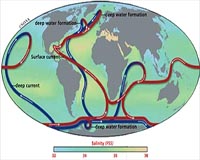| . |  |
. |
Fairbanks AL (SPX) Aug 17, 2009 The same things that make Alaska's marine waters among the most productive in the world may also make them the most vulnerable to ocean acidification. According to new findings by a University of Alaska Fairbanks scientist, Alaska's oceans are becoming increasingly acidic, which could damage Alaska's king crab and salmon fisheries. This spring, chemical oceanographer Jeremy Mathis returned from a cruise armed with seawater samples collected from the depths of the Gulf of Alaska. When he tested the samples' acidity in his lab, the results were higher than expected. They show that ocean acidification is likely more severe and is happening more rapidly in Alaska than in tropical waters. The results also matched his recent findings in the Chukchi and Bering Seas. "It seems like everywhere we look in Alaska's coastal oceans, we see signs of increased ocean acidification," said Mathis. Often referred to as the "sister problem to climate change," ocean acidification is a term to describe increasing acidity in the world's oceans. The ocean absorbs carbon dioxide from the air. As the ocean absorbs more carbon dioxide, seawater becomes more acidic. Scientists estimate that the ocean is 25 percent more acidic today than it was 300 years ago. "The increasing acidification of Alaska waters could have a destructive effect on all of our commercial fisheries. This is a problem that we have to think about in terms of the next decade instead of the next century," said Mathis. The ocean contains minerals that organisms like oysters and crabs use to build their shells. Ocean acidification makes it more difficult to build shells, and in some cases the water can become acidic enough to break down existing shells. Mathis' recent research in the Gulf of Alaska uncovered multiple sites where the concentrations of shell-building minerals were so low that shellfish and other organisms in the region would be unable to build strong shells. "We're not saying that crab shells are going to start dissolving, but these organisms have adapted their physiology to a certain range of acidity. Early results have shown that when some species of crabs and fish are exposed to more acidic water, certain stress hormones increase and their metabolism slows down. If they are spending energy responding to acidity changes, then that energy is diverted away from growth, foraging and reproduction," said Mathis. Another organism that could be affected by ocean acidification is the tiny pteropod, also known as a sea butterfly or swimming sea snail. The pteropod is at the base of the food chain and makes up nearly half of the pink salmon's diet. A 10 percent decrease in the population of pteropods could mean a 20 percent decrease in an adult salmon's body weight. "This is a case where we see ocean acidification having an indirect effect on a commercially viable species by reducing its food supply," said Mathis. The cold waters and broad, shallow continental shelves around Alaska's coast could be accelerating the process of ocean acidification in the North, Mathis said. Cold water can hold more gas than warmer water, which means that the frigid waters off Alaska's coasts can absorb more carbon dioxide. The shallow waters of Alaska's continental shelves also retain more carbon dioxide because there is less mixing of seawater from deeper ocean waters. Ask any coastal Alaskan and they will tell you that Alaska's waters are teeming with biological life, from tiny plankton to humpback whales. All of these animals use oxygen and emit carbon dioxide. Mathis and other scientists call this the "biological pump." "We are blessed with highly productive coastal areas that support vast commercial fisheries, but this productivity acts like a pump, absorbing more and more carbon dioxide from the atmosphere," said Mathis. "Because of this, the acidity of Alaska's coastal seas will continue to increase, and likely accelerate, over the next decade." Mathis said that it is still unclear what the full range of effects of ocean acidification will be, but that it is a clear threat to Alaska's commercial fisheries and subsistence communities. "We need to give our policy makers and industry managers information and forecasts on ocean acidification in Alaska so they can make decisions that will keep our fisheries viable," said Mathis. "Ecosystems in Alaska are going to take a hit from ocean acidification. Right now, we don't know how they are going to respond." Share This Article With Planet Earth
Related Links University of Alaska Fairbanks Water News - Science, Technology and Politics
 Scientists Refine And Redefine Seawater Equation
Scientists Refine And Redefine Seawater EquationMiami FL (SPX) Aug 13, 2009 This summer, one of the world's leading ocean science bodies, the United Nations Educational, Scientific and Cultural Organization's and Intergovernmental Oceanographic Commission adopted the new international thermodynamic equation of state for seawater called TEOS-10. A complex, dynamic mixture of dissolved minerals, salts, and organic material, seawater has historically ... read more |
|
| The content herein, unless otherwise known to be public domain, are Copyright 1995-2009 - SpaceDaily. AFP and UPI Wire Stories are copyright Agence France-Presse and United Press International. ESA Portal Reports are copyright European Space Agency. All NASA sourced material is public domain. Additional copyrights may apply in whole or part to other bona fide parties. Advertising does not imply endorsement,agreement or approval of any opinions, statements or information provided by SpaceDaily on any Web page published or hosted by SpaceDaily. Privacy Statement |